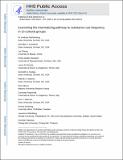| dc.contributor.author | W Andrew Rothenberg, Jennifer E Lansford, Lei Chang, Kirby Deater-Deckard, Laura Di Giunta, Kenneth A Dodge, Patrick S Malone, Paul Oburu, Concetta Pastorelli, Ann T Skinner, Emma Sorbring, Laurence Steinberg, Sombat Tapanya, Liliana Maria Uribe Tirado, Saengduean Yotanyamaneewong, Liane Peña Alampay, Suha M Al-Hassan, Dario Bacchini, Marc H Bornstein | |
| dc.date.accessioned | 2022-01-20T11:39:35Z | |
| dc.date.available | 2022-01-20T11:39:35Z | |
| dc.date.issued | 2020 | |
| dc.identifier.uri | https://repository.maseno.ac.ke/handle/123456789/4419 | |
| dc.description.abstract | Use of alcohol, tobacco, and drugs (i.e., substance use) is a leading cause of global health burden
for 10-to-24-year-olds, according to the World Health Organization’s index of number of years of
life lost, leading international health organizations to prioritize the prevention of substance use
before it escalates in adolescence. Pathways defined by childhood externalizing symptoms and
internalizing symptoms identify precursors to frequent substance use toward which interventions
can be directed. However, these pathways are rarely examined beyond the United States and
Europe. We investigated these pathways in our sample of 1083 children from 10 cultural groups
followed from ages 8–14. We found that age-10 externalizing symptoms predicted more frequent
mother-reported age-13 and self-reported age-14 substance use. We also found that a depressive
pathway, marked by behavioral inhibition at age 8 and subsequent elevation in depressive
symptoms across ages 8–12 predicted more frequent substance use at age 13 and 14. Additionally,
we found a combined externalizing and internalizing pathway, wherein elevated age-9 depressive
symptoms predicted elevated externalizing symptoms at age-10 which predicted greater peer
support for use at age-12, which led to more frequent substance use at age-13 and-14. These
pathways remained significant within the cultural groups we studied, even after controlling for
differences in substance use frequency across groups. Additionally, cultures with greater
opportunities for substance use at age-12 had more frequent adolescent substance use at age-13.
These findings highlight the importance of disaggregating between- and within-culture effects in
identifying the etiology of early adolescent substance use | en_US |
| dc.publisher | Pergamon | en_US |
| dc.subject | externalizing symptoms; internalizing pathway; substance use frequency; adolescence; cultural differences; multilevel | en_US |
| dc.title | Examining the internalizing pathway to substance use frequency in 10 cultural groups | en_US |
| dc.type | Article | en_US |

